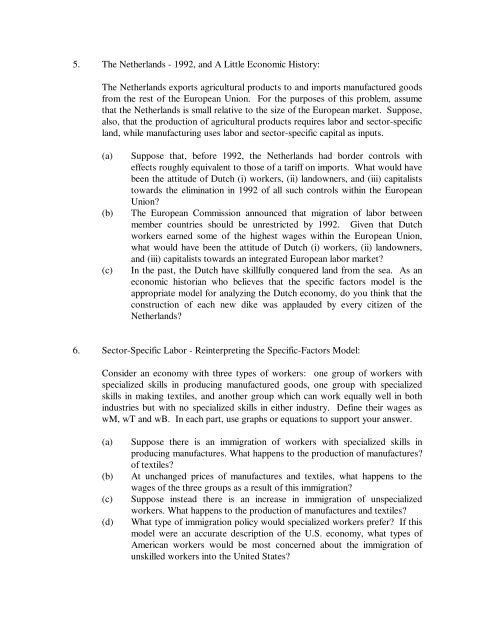Chapter 6 TRADE AND LOCAL INCOME DISTRIBUTION: THE ...
Chapter 6 TRADE AND LOCAL INCOME DISTRIBUTION: THE ...
Chapter 6 TRADE AND LOCAL INCOME DISTRIBUTION: THE ...
You also want an ePaper? Increase the reach of your titles
YUMPU automatically turns print PDFs into web optimized ePapers that Google loves.
5. The Netherlands - 1992, and A Little Economic History:<br />
The Netherlands exports agricultural products to and imports manufactured goods<br />
from the rest of the European Union. For the purposes of this problem, assume<br />
that the Netherlands is small relative to the size of the European market. Suppose,<br />
also, that the production of agricultural products requires labor and sector-specific<br />
land, while manufacturing uses labor and sector-specific capital as inputs.<br />
(a) Suppose that, before 1992, the Netherlands had border controls with<br />
effects roughly equivalent to those of a tariff on imports. What would have<br />
been the attitude of Dutch (i) workers, (ii) landowners, and (iii) capitalists<br />
towards the elimination in 1992 of all such controls within the European<br />
Union?<br />
(b) The European Commission announced that migration of labor between<br />
member countries should be unrestricted by 1992. Given that Dutch<br />
workers earned some of the highest wages within the European Union,<br />
what would have been the attitude of Dutch (i) workers, (ii) landowners,<br />
and (iii) capitalists towards an integrated European labor market?<br />
(c) In the past, the Dutch have skillfully conquered land from the sea. As an<br />
economic historian who believes that the specific factors model is the<br />
appropriate model for analyzing the Dutch economy, do you think that the<br />
construction of each new dike was applauded by every citizen of the<br />
Netherlands?<br />
6. Sector-Specific Labor - Reinterpreting the Specific-Factors Model:<br />
Consider an economy with three types of workers: one group of workers with<br />
specialized skills in producing manufactured goods, one group with specialized<br />
skills in making textiles, and another group which can work equally well in both<br />
industries but with no specialized skills in either industry. Define their wages as<br />
wM, wT and wB. In each part, use graphs or equations to support your answer.<br />
(a) Suppose there is an immigration of workers with specialized skills in<br />
producing manufactures. What happens to the production of manufactures?<br />
of textiles?<br />
(b) At unchanged prices of manufactures and textiles, what happens to the<br />
wages of the three groups as a result of this immigration?<br />
(c) Suppose instead there is an increase in immigration of unspecialized<br />
workers. What happens to the production of manufactures and textiles?<br />
(d) What type of immigration policy would specialized workers prefer? If this<br />
model were an accurate description of the U.S. economy, what types of<br />
American workers would be most concerned about the immigration of<br />
unskilled workers into the United States?
















